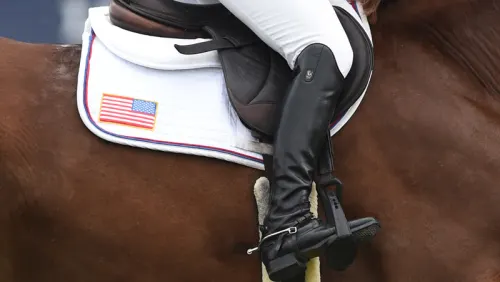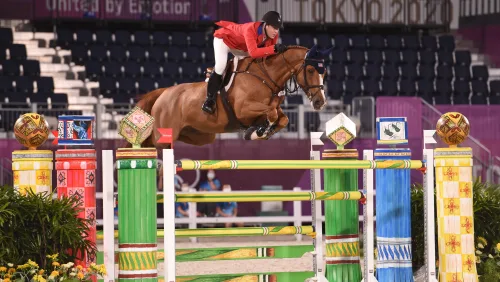Producing—and selling—top horses isn’t easy, but our columnist believes we’re getting closer to seeing U.S. team riders on U.S.-bred horses once again.
Compared with some parts of the world, the breeding of jumping horses in North America is still in its infancy. Scattered throughout the continent are medium- to large-scale breeders who are producing horses on par with those found in the major breeding nations. In addition, some individuals produce one or two foals a year that are of real quality.
The formula for producing top foals is relatively simple: Take one mare of exceptional quality for producing a modern sport horse, cross her with the right stallion, and give mare and foal the best of care. Even then a lot of luck is needed to get a potential international star.
For commercial breeders, which means anyone who isn’t planning on keeping every foal produced, the job is only half done when a healthy foal is born. Since most buyers here in North America are looking for horses ready to compete, how does the breeder ensure that the quality he’s bred gets the education to reach its potential?
The number of North American-bred horses in our show rings is unquestionably on the upswing. Cheryll Frank, of the Young Jumper Championships and International Jumper Futurity, constantly peruses competition results to keep track of graduates of both programs. Although more and more U.S. horses are hitting the charts, we’re likely still letting a lot of our own good ones fall through the cracks, and imports (mainly from Europe) continue to arrive every week.
What are some of the challenges our breeders face as they strive to market homebred horses to buyers who have looked to Europe for so long?
Geography
Let’s face it, North America is a lot of territory to cover when searching for one special horse that fits the bill for a client. Breeders are scattered everywhere. Despite today’s video technology, it’s expensive and time consuming to fly thousands of miles to look at one horse. Europe isn’t next door, but at least a lot of horses can be seen in one trip. Most European horses have verifiable records of their show ring mileage. Knowledgeable dealers learn what repeat shoppers are looking for and spend a great deal of time visiting farms and competitions to know what’s out there so that buying trips condense as many horses as possible into a short amount of time. We can’t change our geography, but we must find ways to simplify the shopping process on this side of the Atlantic. Getting horses into the right hands so they go on to be successful is still the best advertising there is for any commercial breeder.
No Established Marketplace
ADVERTISEMENT
The marketing of sport horses—to European and foreign buyers—in Europe has been established over many decades. Auctions, along with professional dealers, help set realistic market values and make it easier for breeders to know what their stock is worth. For younger horses especially, these elements aid in standardizing (to the degree possible with living, breathing creatures) what the buyers expect to see a horse do, whether on video or live.
While horses below 5 years aren’t expected to be competing, 3-year-olds are shown free jumping in a professional manner, and 4-year-olds are typically shown under saddle going freely forward with light contact and trotting and/or cantering small jumps. A friend doing an Internet search for a 3- or 4-year-old prospect pointed out to me the huge variation in what could be seen on video from here versus abroad. We have lots of well-done websites, but often the horses aren’t presented well. In addition, if we had knowledgeable and honest dealers who kept track of what was available in their area, the search process might be less frustrating for buyers.
Costs
Overhead on any breeding operation is substantial, taking into account the cost of land, feed, veterinary and hoof care and labor. Most daunting of all? Often it’s the cost involved in getting young stock up to the level of age and experience demanded by the American market. Too few buyers shop for foals through 3-year-olds, and, for jumper prospects, even a 4-year-old is still a “baby.” Unlike many European countries that offer local one-day events, often specifically for 4- to 6-year-olds, in North America that all-important “mileage” buyers are looking for must be obtained primarily at the larger multi-day shows. These shows are much more expensive, and seldom does this experience even suit the really green ones.
It’s not realistic to expect show management to underwrite the development of young horses by forgoing profit at their very high overhead events, but clearly some other alternatives must be sought. As other countries know, more good comes from single day outings for horses new to the game. Young horses thrive on simple, inviting courses with the opportunity to repeat and ensure a positive experience. The YJC is introducing a “Development Program” which records rounds and scores at certain events below the recognized level. It’s expected to take some time for this concept to take off, but details are available at www.youngjumpers.com.
Knowledgeable Trainers
Unlike earlier generations of American trainers who most often dealt with off-the-track Thoroughbreds, most of today’s younger professionals learned their trade primarily on European-trained horses. Few have ever brought a horse up through the ranks to grand prix level, much less started one from scratch. Today’s professional is recognized solely for what he wins in competition, riding and coaching students on “made” horses.
A somewhat different skill set is needed for training young horses. When the expectations placed on a young horse are the same as those demanded of seasoned performers the result is often a horse that does not develop well and is unlikely to reach its full potential. Even worse, the horse with a naturally careful and sensitive temperament—the one most likely to become the superstar in our discipline—is typically the easiest one to ruin if not managed correctly and allowed to mature and learn at his own pace.
Trainers with a real talent and love for young horses invariably put the best early foundation on them. Plus, more time “on the farm” benefits these youngsters. A steady diet of traveling to show after show with a serious competition rider isn’t the way horses are developed abroad.
ADVERTISEMENT
So far, word of mouth has been the only way to locate potential trainers for young horses in a given area, but the U.S. Equestrian Federation Breeders Committee is working on establishing a database of such individuals. Hopefully this will be online in the near future.
Course Designers Who Don’t “Get” Young Horses
More than any of the issues listed above, the complaint that most often reaches my inbox (and is prominent in various forums or discussions around the country) regards course design for young horses. The cost of putting mileage on young stock is certainly of concern, but when owners invest in showing their horses only to find that their horses get a negative experience, it’s especially disheartening.
I’ve lost track of the times I heard that the 5-year-olds were asked to jump the lowered course set for a 1.40-meter class or the same track as the children’s/adult or 1.20-meter class. While this helps move the schedule along for the show it fails to take into account the purpose of the various classes. In every class except the young jumpers it’s presumed that the horses have the requisite experience to be entered in the class; the job of the course designer is to ensure that only those horses who are suitably trained and ridden are able to go clear. It’s all about who wins. Especially in classes for amateurs or juniors, the vast majority of the horses have an excess of experience behind them not just at the current height but usually over much higher courses—the complete opposite of the case for the young horses.
While the young horse classes do have winners, the main purpose must be to provide the foundation of experience that will give horses the chance to progress as far as their ability can take them. Young horses need a slow, structured education over courses designed first and foremost to maintain their confidence, to teach and not punish them for the mistakes that they are bound to make. Young horse classes should consider every horse in the class, not just the ones being ridden the strongest by the most experienced riders. That spooky colt at his first show might just be the next Uceko or Simon, provided his confidence and carefulness aren’t taken away before he even gets out of “first grade.”
Building good courses for young horses is not the same as building good grand prix courses. It takes awareness of how a green horse will react, along with a desire to see the number of American-made international horses rise. It’s revealing watching video of these classes. Whether in France, Holland, Germany or the Czech Republic you see only simple, flowing courses, well-built fences, and a lack of any distance or other technical questions. Their jumps may be a touch higher toward the end of the summer, but the courses invariably encourage the horses to go freely forward without an excess of square oxers or any hint of sharp or awkward turns. Unfortunately, this is too often not what we find here.
Breeding and training any kind of young horses is a labor of love. There are no guarantees, except that disappointments will inevitably be a part of the process. Yet the reward that comes with seeing an animal you have produced achieve every bit of its potential is hard to describe. I congratulate all the breeders who continue to pour so much of themselves into producing ever more quality in horses bred in North America. Congratulations also must go to those unsung heroes who give horses the sort of start that provides them every chance to go as far as they can. Yes, there are challenges in developing a system of producing jumpers into something that rivals that of our competitors, but many individuals around the country are tackling them in large and small ways. The dream many of us hold—seeing U.S. teams once again mounted on U.S.-bred horses—is approaching reality.
Noted international course designer Linda Allen created the show jumping courses for the 1996 Atlanta Olympic Games and the 1992 FEI World Cup Finals. She’s a licensed judge, technical delegate and a former international show jumper. She lives in Fillmore, Calif., and San Juan Cosalá, Jalisco, Mexico, and founded the International Jumper Futurity and the Young Jumper Championships. Allen began writing Between Rounds columns in 2001.














